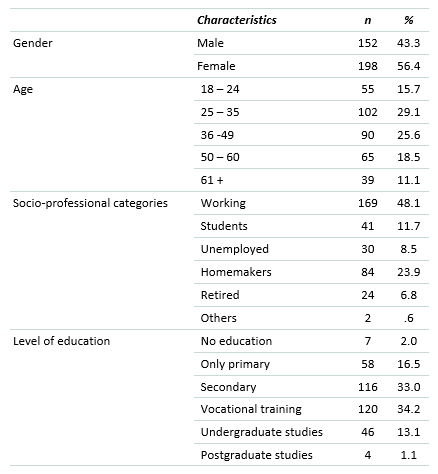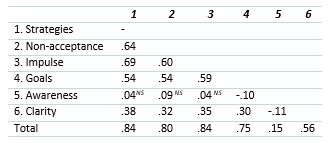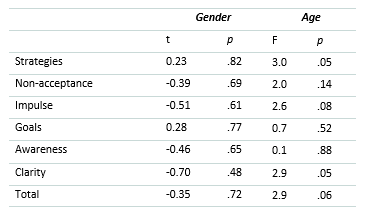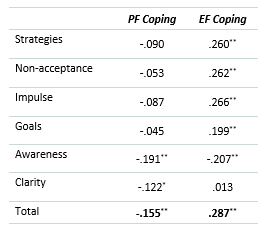Introduction
Emotion regulation is defined as all processes involved in adapting to relatively strong emotional episodes (Kopp, 1989; Berking, 2007, 2010). Most researchers agree that emotions are not uncontrollable forces and, on the contrary, we can modulate them when necessary (Koole, 2009; Medrano & Trogolo, 2014). Adaptive emotion regulation consists in modulating - not eliminating - the experience of emotions (Gratz & Roemer, 2004; Kaufman et al., 2015), which requires that emotions be tracked and evaluated in order to get a better understanding of the emotional state (Delelis et al., 2011; Gross & Muñoz, 1995).
(Gross, 1998) defines emotion regulation as the set of mechanisms used to influence our emotions when they appear, and particularly the way we feel and express those emotions. According to (Thompson, 1994), emotion regulation refers to the extrinsic and intrinsic processes through which emotional reactions, their intensity and temporality are expressly monitored, evaluated and modified.
Additionally, a relationship between emotion regulation and the physical and mental health of individuals has been demonstrated (Gross & Muñoz, 1995; Sapolsky, 2007). Patients suffering from chronic pain who use more emotion expression strategies, might report less pain than patients who use fewer emotion regulation strategies. In particular, it was observed that breast cancer patients who managed strategies for regulating and expressing emotions checked with the doctor less frequently, had a better perceived state of overall physical health and a higher breast cancer survival rate (Stanton et al., 2000).
The two most well-known models used to study the regulation of feelings are emotion regulation and coping strategies, which differ in their level of specificity. Emotion regulation strategies are more general and focused on the recognition of emotions. They may, in turn, determine coping strategies, which are more specific and focused on a specific situation (Delelis et al., 2011; John & Gross, 2007). Coping comprises the fluctuating cognitive and behavioral efforts deployed to handle specific external and/or internal demands thought to be excessive or overwhelming regarding the individual’s resources (Lazarus & Folkman, 1984, p.141). This process explains the acts and thoughts of individuals faced with a stressful situation, and acts as a stabilizing factor that permits psychological adaptation. Coping is the result of a parallel assessment of a subject’s cognitive and affective skills, as well as the threat and its context. The scientific literature recognizes two types of coping strategies: strategies focusing on the problem solution, and strategies focusing on how to cope with negative emotions or psychological tension resulting from the stressful situation (Moos & Billings, 1986). Emotion regulation strategies are thus understood to underly coping strategies, and in fact determine them (Delelis et al., 2011). Consequently, it is thought that emotion regulation strategies are the basis of coping strategies and, in fact, they determine them (Delelis et al., 2011).
Various instruments have been developed to assess emotion regulation. One is a self-evaluation of emotion regulation processes developed by (Gratz and Roemer, 2004) known as DERS (Difficulties in Emotion Regulation Scale). It was first validated (α = 0.93) using psychology students, but since then several performing, and adaptations have demonstrated its psychometric relevance. The DERS proposes six independent but related domains that provide insight into the difficulties involved in regulating emotion: (a) lack of consciousness of emotional reactions or Awareness, (b) lack of clarity in emotional reactions or Clarity, (c) lack of acceptance of emotional responses or Non-Acceptance, (d) limited access to emotion regulation strategies perceived as effective or Strategies, (e) difficulty controlling impulsive behavior when experiencing negative emotions or Impulse, and (f) difficulty identifying goal-directed behavior when experiencing negative emotions or Goals (Gratz & Roemer, 2004). This scale highlights the importance of “distinguishing between the awareness and understanding of emotional responses, as well as between the ability to act in desired ways and refrain from acting in undesired ways when experiencing negative emotions” (Gratz & Roemer, 2004, p. 52). This scale was first validated in English but has since been validated in other languages such as in French (Dan-Glauser & Scherer, 2013) and in Spanish: with the general population (Hervás & Jódar, 2008); with Spanish teenagers (Gómez-Simón, Penelo, & De la Osa, 2014); with Mexican teenagers (Marín et al., 2012); and with university students in Argentina (Medrano & Trógolo, 2014) and Colombia (Muñoz-Martínez, Vargas, & Hoyos-González, 2016).
Several brief versions, based on the the original 36-item version, have been proposed in English: DERS-SF by (Kaufman, Xia, Fosco, Yaptangco, Skidmore & Crowell, 2015), DERS-16 by (Bjureberg et al. 2016) and DERS-18 by (Victor & Klonsky, 2016) (Hallion et al., 2018), but to our knowledge no a brief version in Spanish has been validated. (Kaufman et al. 2015) targeted to develop a shorter version of the DERS, given the possible redundancy of some items in the original 36-item version developed by (Gratz and Roemer, 2004). According to (Kaufman et al. 2015), this redundancy could be source of frustration and fatigue during the completion of the scale. They argued that a brief version would be more effective to evaluate the six dimensions covered by the scale and then proposed a brief version, named DERS-SF, while preserving the factorial structure of the original DERS in the six dimensions developed by (Gratz and Roemer, 2004). This version has the same psychometric qualities as the DERS. In other words, a briefer version of the scale would be easier to administrate with populations at varied socio-educational levels, and it would make data collection easier to carry out under difficult circumstances or with highly heterogenous population. This study seeks to meet this demand.
In conclusion, the review of literature allowed to identify two issues: the first one deals with the existing validations of the DERS reference scale (Gratz & Roemer, 2004), which is the most widely used, translated, and administered in Spanish speaking populations. Most of the versions have been used with teenage population (Gómez-Simón et al., 2014; Marín et al., 2012) or university student population (Medrano & Trógolo, 2014; Muñoz-Martínez et al., 2016). Its validation on general or adult population has only been carried out in Spain (Hervás & Jódar, 2008) and any other version is found in Latin America. The second problem is that there is no brief version in Spanish language and therefore no validation either in Spanish or Latin American context. A short version could reduce the redundancy of the full scale or facilitate its use in non-clinical contexts and within the general population. For this reason, our study aims to respond to this double problem, offering a brief version of the DERS in the context of Spanish-speaking population and particularly in Latin America.
Method
Objectives and hypothesis
The objective of this study is to propose a brief version of the DERS scale in Spanish-speaking context, and to verify its psychometric value in measuring any difficulties with emotion regulation experienced by a population described as ‘general’, but nonetheless exposed to environmental risks, in view of performing it in contexts with a great socio-economic diversity. The goal is to be able to confirm the construct validity of a scale. The hypothesis is that a brief version scale for Spanish speakers, will obtain the same psychometric validation criteria as the original scale version.
Participants and procedure
Participants (n = 351), native Spanish speakers and non-clinical population, completed the questionnaire, all of them are inhabitants of Cartagena city in the Caribbean region of Colombia. Although UNESCO has declared the city a world heritage site, it is highly vulnerable to the effects of climate change (marine submersion and coastal erosion). The tool was administered in the participants’ homes, in the framework of a broader study on adaptation to the risks of marine submersion. It took about 30 minutes to implement the scale, after the interviewer stated to the participants the study purpose and obtained their informed, written consent. Participation was entirely voluntary and there was no monetary compensation. Participants with more than 2% of non-responses were excluded from the final sample. Participants have been ranged from18 to 90 years old (M = 39.92 years, SD=14.98, 56.4% female). Regarding to employment status, 48.1% of the sample was active working population, and 48.4% of participants completed higher education (see Table 1).
This is a convenience sample since it integrates all coastal neighborhoods of Cartagena city. The present study is included in a more general study on adaptation to the effects of climate change. The objective was to have heterogeneity in the sociodemographic characteristics of these neighborhoods’ inhabitants. No preference was given to any criteria. The variety of criteria is important to neutralize the effect of some sociodemographic characteristic. That is why a control of some of these variables (age and gender) has been realized on the results (see data analysis section). These characteristics are not expected to influence the results. The survey was carried out using face-to-face interviews. The participants were debriefed (by informing them of the aims of the study) and their informed consent to participate was obtained. The mean duration for completing the questionnaire was 15 minutes. The ethics committee of the University of Nantes validated the protocol.
Materials
The main instrument employed in this study was a short, 18-item Spanish version of (Gratz and Roemer’s Difficulties in Emotion Regulation Scale (DERS), 2004). We chose the 18-item English version proposed by (Kaufman et al. 2015) as the basis for our Spanish version because it has an excellent internal reliability level (α = .95). The corresponding Spanish texts were then taken from the complete Spanish version by (Gómez-Simón, Penelo and De la Osa, 2014). Participants are asked to indicate how often each item is applicable to themselves on a 5-point scale from 1 to 5, where 1 = almost never, 2 = sometimes, 3 = about half the time, 4 = most of the time, and 5 = almost always.
As explained in the introduction and according to the literature, emotion regulation strategies are more general than coping strategies since the former focus on recognition of emotions, and the latter focus on specific situations. In this way, the regulation of emotions underlies coping strategies and can determine them (Delelis et al., 2011; John & Gross, 2007). This is the reason why it was considered that a predictive analysis of the DERS on coping strategies can provide an indicator of construct validity. A scale of coping strategies (Coping) by (López and Marván, 2004, 2012) was used to analyze convergent and divergent validity. This scale consisting of 26 items is set in 2 dimensions: problem-focused coping (14 items, α = 0.79) and emotion-focused coping (12 items, α= 0.76).
Data analysis
Two types of analysis have been done. Firstly, descriptive analyzes that sought to establish psychometric reliability of the items and dimensions, controlling by variables such as age and gender. Secondly, analyzes that confirm the statistical and construct scale validity, through a confirmatory factor analysis and a convergent and divergent validity analysis.
First, descriptive analyses were performed. These analyses took the mean and other psychometric distribution indexes (skewness and kurtosis) into account for each item and each dimension. Internal reliability indexes were calculated using Cronbach’s alpha.
In addition, a control analysis of sociodemographic variables, age and gender was carried out, in order to neutralize an eventual effect of these variables (parasite variable) on the scale psychometric structure and increase its internal validity. Comparisons have been made between men and women (t test) and between different age categories (Fischer's F). If differences are not significant, we will have the means to conclude lack of effect and guarantee of validity. The construction of the age categories does not obey any specific theoretical criteria in psychology and corresponds to an arbitrary statistical distribution. No element in the literature encourages us to propose any hypothesis in this regard, the objective is only to control the effect of the variable on the psychometric structure of the scale.
Secondly, a confirmatory factor analysis (CFA) was performed to verify that the factor structure proposed by the authors´ scale was valid in the Spanish brief version. The fit indices were used to assess model fit comparative fit index (CFI), Tucker Lewis index (TLI), Standardized Root Mean Square Residual (SRMR) and Root Mean Square Error of Approximation (RMSEA). A value greater than 0.90 for the CFI and TLI suffices (Tucker & Lewis, 1973; Bentler, 1992; Schumacher & Lomax, 1996). An RMSEA or SRMR of less than 0.08 is acceptable, though the ideal value is 0.05 (Browne & Cudeck, 1993; MacCallum et al., 1996; Pui-Wa & Qiong, 2007). Regarding the use of X 2, the model used may not adjust correctly to values. In this case, (Wheaton et al. 1977) suggest calculating a relative chi square (X 2/ df or CMIN / df) and if the result < 3.00 the fit is correct.
Finally, convergent and divergent validity were determined using the correlation between the DERS and the two dimensions of Coping; the correlation with problem-focused coping was expected to be negative and the relationship to emotion-focused coping positive.
Results
Descriptions and reliability
Reliability indexes for brief version of DERS is excellent (α = 0.83). In Table 2, the descriptive analysis, mean, standard deviation, skewness and kurtosis are given for each item of the scale, as well as the mean, standard deviation and reliability for each dimension. Cronbach’s alpha values are quite sensitive to the number of items in the scale. As there are only 3 items by dimension, in this case it may be more appropriate to report the mean inter-item correlation for the items which must be between .20 and .50 (Briggs & Cheek 1986).
Table 2 descriptions and reliability of items and dimensions in the DERS-SSF.
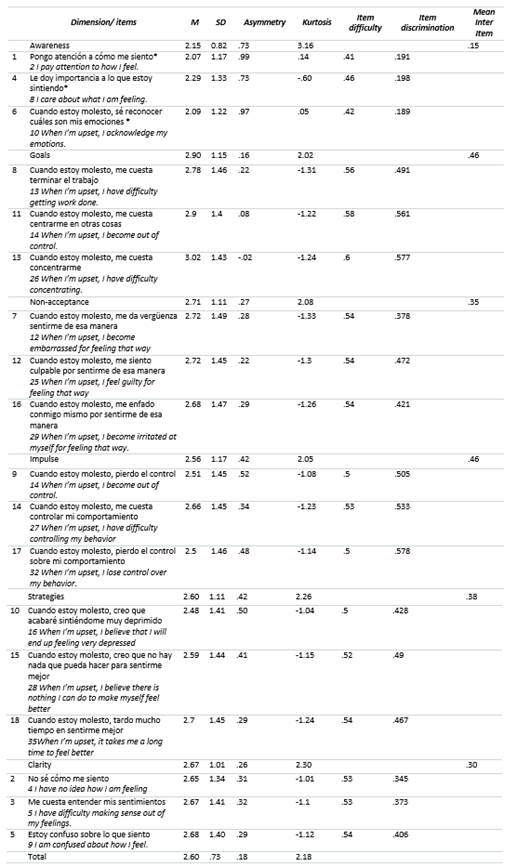
Note: *Inverted item; the item and its number in the original (Gratz & Roemer, 2004) version are given in italics.
The matrix of correlations between dimensions (Table 3) shows that the Awareness dimension does not correlate meaningfully with the other dimensions. All the other correlations are significant (p > .05).
To test construct validity, a differential analysis was made using gender and age as criteria. Comparison of the means (Student’s t-test) shows that there are no differences for gender (table 4), so the average response does not vary significantly with this variable. This supports validity of the scale. Likewise, when the three age categories are compared there are no significant differences for the age variable: under 30 (n=118), between 30 and 50 (n=138) and over 50 (n=93) (see Table 4).
Confirmatory factor analysis (CFA) of the short Spanish version of the DERS
A confirmatory factor analysis was performed to verify that the factorial structure proposed by the authors of the original DERS scale remained unchanged. The hypothesis stated that the factorial structure would be the same in the brief Spanish version, and that is indeed the case of both types of answer options (traditional and simplified) proposed in this study. In group 1, i.e., where there were five answer options, FIT indexes were excellent: X²= 143.91 (120 df), p= .06 (X 2 / df = 1.19), CFI= .99, TLI = .99, RMSEA=.02 [.0, .03], SRMR = .049. Results showed that the factorial structure of the original scale was indeed conserved, confirming the validity of these brief Spanish versions of the DERS.
Convergent and divergent validity
To establish the convergent and divergent validity of the brief Spanish DERS version, a correlation was established between the two Coping sub-scales proposed by (López and Marván, 2004, 2012). First, to assess internal consistency, Cronbach’s alpha was calculated for each sub-scale. The reliability of the problem-focused Coping sub-scale (PF Coping) was α = 0.72 and for the emotion-focused Coping sub-scale (EF Coping) was α = 0.70.
As expected, results showed that the global DERS correlated negatively with problem-focused coping strategies and positively with emotion-focused coping strategies. This tendency was also observed in DERS dimensions, except for the Awareness dimension, which had a negative correlation with emotion-focused coping. It should be noted that results for the Awareness dimension were somewhat contradictory, leading to question the relevance of this dimension, or in any case the psychometric fitness of the items it includes.
Discussion
In conclusion, the 18-item brief version of the DERS in Spanish, fulfilled completely the expected reliability and validity criteria inspired by the original (Gratz and Roemer model, 2004). The only issue that seemed to be a concern was the lack of consistency in the Awareness dimension. This dimension had very low reliability indexes, a phenomenon observed in other studies such as the DERS, original version, validation study by (Gómez-Simón, Penelo and De la Osa, 2014) carried out on a group of Spanish adolescents. Our results also showed very low reliability for this dimension. Similarly, analysis of correlations amongst the dimensions showed no significant correlations between awareness and the other dimensions. This has been observed in other studies, most notably in the first adaptation of the original scale to Spanish (Hervás & Jódar. 2008). One explanation may be that attention to emotions can be functional or dysfunctional and depends on the regulatory capacity of the individual (Lischetzke & Eid, 2003). Therefore, the correlation between the strategies focused on emotions suggested an instability in this dimension because it was a negative correlation. This result has also been observed in the validation of other brief DERS versions in English. For example, in the 16-item version proposed by (Bjureberget al. 2016), the Awareness dimension was not included in the final version because none of the items presented a strong correlation with the total score of the scale in comparison with the other dimensions, and the authors indicated that this tendency had already been noted in previous studies (for example Neumann et al., 2010). The authors concluded that this dimension is of little importance to the overall construction of emotional dysregulation, at least regarding the way dysregulation is evaluated by the DERS.
Indeed, in this six-dimensional model, the “awareness” dimension is only rarely correlated with the other dimensions. Whereas for some authors (Tull et al., 2007), the “awareness” dimension only correlates with two or any other dimension of the DERS, here this dimension only correlates negatively with one of the five other dimensions (Goals). Some authors (e.g. Bjureberg et al., 2016; Hallion et al., 2018), proposed to test a five-dimensional model, removing this “awareness” dimension. This model has psychometric qualities that are significantly better than the six-dimensional model. Previously, (Bardeen et al. 2012) already suggested considering the SSD without the "consciousness" dimension. In fact, these authors examined the latent structure of the SSD and suggested that the "consciousness" dimension does not cover the same construct as the other SSD dimensions and therefore it should be studied independently. They proposed a revised version of the DERS with the same psychometric qualities as the original version but removing the “awareness” dimension.
For (Hallion and others, 2018), the “awareness” dimension does not seem to measure the same construct as the other dimensions of the DERS. Rather, this dimension is a process that is at the core of emotional regulation. According to them, this could explain why this “awareness” dimension does not correlate regularly with the other DERS dimensions or the overall score, in the long or short DERS versions. While it may not be possible to override the interest of emotional awareness in the process of emotional regulation, it seems clear that the links between awareness, assessed by the DERS, and the effectiveness of emotional regulation are more complex than the links that can be observed with other dimensions such as the access to strategies, or their implementation. Thus, we endorse the idea that the awareness dimension, as it is performed in the DERS, can refer to a construct that differs from the other dimensions of this scale.
Emotional dysregulation, or difficulty regulating emotions, is defined as a reduced capacity to recognize and differentiate between emotions, and to monitor, evaluate and modify intense emotional states. Difficulty in regulating emotions has been linked to problems such as depression, anxiety and some maladaptive behaviors (Gómez-Simón, Penelo & De la Osa, 2014; Marín et al., 2012). In the target population of this study the daily exposure to environmental risks may create problems of this type. In any case, the capacity to regulate emotions without undue difficulty is particularly important when individuals are constantly exposed to certain risks: this capacity allows them to maintain stable emotions and a willingness to face and deal with the stressful situation.
Our study did not aim to establish a relationship between the fact of living in a submersion risk area, or to integrate a possible feeling of vulnerability in the responses of this scale. Our goal here is to prove reliability and validity of this brief version to measure the difficulty in regulating emotions, as the original scale does. However, it makes sense to think that the context and particularly the living conditions can influence the tendencies of the responses. The results do not show a significant level of difficulty in emotions regulations, based on item response scores. This may lead us to consider that the fact of living in a risk zone (without known whether the participants are really aware of this exposure), does not have a significant effect; in other words, it does not constitute an explanatory variable of emotion regulations. Interindividual differences could be identified, but this is not the objective of our study. From a methodological point of view, this version of the scale should be able to identify treatment effects when comparisons can be made between the general and the clinical population.
In the future, and once the validity of the scale would be confirmed, this measure of difficulty in regulating emotions will need to be integrated with other measures of concern. On a theoretical level, we have seen the interest and the relevance of the correlation with coping strategies, it will be necessary to broad this analysis with aspects such as risk perception or other measures related to anxiety or emotion expressions. On a practical level, this version of the scale will allow deeper thinking on how to deal with environmental risks or other difficult situations that a specific society faces. This version makes possible to assess quickly and easily this dimension in very different cultural populations. This study allowed us to validate a brief version for the scale, because the high demand to use the scale with populations that may have difficulties in completing the traditional version. These difficulties may be related to the understanding of the scale, the complexity of the answer options or to the situational factors such as time constraints or the conditions under which the instrument is performed. In any case, results show that a simplified scale has the same level of validity as the traditional version.
The main limitation of this study is associated with results for the Awareness dimension, which was found to be unreliable and thus in our Spanish brief version is not relevant for future applications. This finding coincides with other studies which also suggest that this dimension should not be used, or that question its relevance (Bjureberg et al., 2016). Finally, we consider that the Six-dimensional solution (including Awareness) can be used, keeping in mind that this dimension must be interpreted separately from the other dimensions. On the other hand, an element to be considered is the fact that our sample consisted all in adult population exposed to an environmental risk (marine submersion) and inhabited in the same city. We think that a larger sample, including inhabitants of other cities, in fact, an even more heterogeneous sample, could even get better results in terms of stability and relevance of the psychometric structure of the scale. Other studies within Spanish-speaking populations from different cities, countries, could be interesting. It would be useful to conduct the Spanish version of this proposed study in other populations, as adolescents or even clinical populations. Such testing would provide new insights into the use of the proposed scale.














